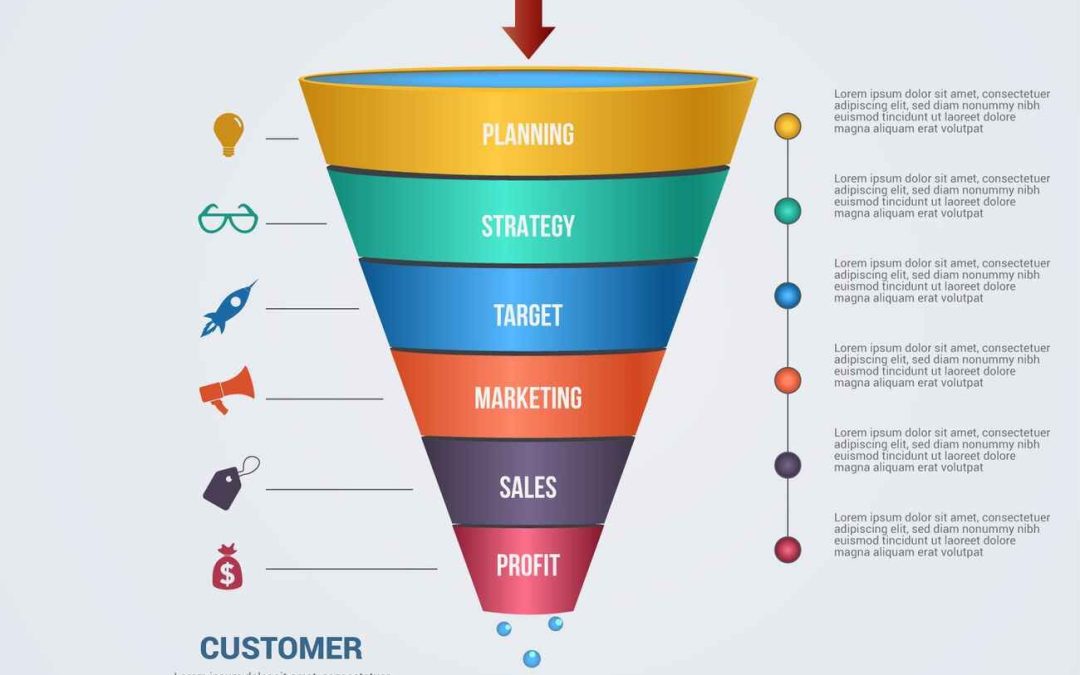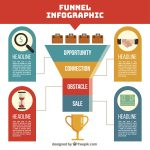A clear sales funnel is important for businesses of all kinds in today’s digital world because it helps them get traffic, get people interested, and turn leads into loyal customers. The key to developing your business, whether you’re just starting out or have been around for a while, is knowing how to construct and optimize your sales funnel. This complete tutorial will explain the main ideas behind a sales funnel, provide you methods to make your own funnel, and show you how each stage is important for the success of your business.
What is a sales funnel, and why should you care?
A sales funnel is a marketing tool that shows the path a potential client travels from their first contact with your company to the point where they buy something and even beyond, to keeping them as a customer and building loyalty. The “funnel” idea works because it starts with a large group of possible leads at the top and ends with the few who really convert.
The sales funnel’s goal is not merely to sell a product, but also to lead potential customers through a journey that builds trust and adds value at every step. A well-designed funnel makes sure that every phase of the customer journey is handled well, which makes it more likely that leads will do what they need to do to become customers.
A Look at the Most Important Parts of a Sales Funnel
There are usually four steps in a good sales funnel: Awareness, Interest, Decision, and Action. To get prospects to the next level, you need to use different techniques at each stage. This will lead to a purchase and more.
1. The first step is to become aware (top of the funnel).
At this point, you want to get the attention of people who might not know about your business or what it has to offer. The goal of the awareness stage is to get as many leads as possible by casting a wide net. These leads may know about an issue they’re having, but they don’t yet know about the remedy you offer.
Goal: The main goal here is to get your brand in front of potential clients and let them know about the problem your product solves.
Ways to Put into Action:
- material marketing means getting leads by making high-quality, interesting material like blog posts, articles, videos, and infographics. This content should talk about typical problems in your field and offer solutions without seeming like a sales pitch.
- SEO and SEM: Make sure your material is optimized for search engines so that it shows up high in search results for relevant queries. To get more organic traffic, use SEO recommended practices including optimizing keywords, linking to other pages on your site, and building backlinks.
- Social media marketing means posting useful, interesting, and engaging material on sites like Facebook, LinkedIn, Instagram, and Twitter. Use both free and paid postings to get the most people to see your content.
- Paid Ads: Use Google, Facebook, and other sites to run targeted advertising campaigns that will reach more people and bring in potential customers who may not know about your company.
2. The Interest Stage (Middle of the Funnel)
The following stage is to get your leads interested in your brand once they know about it. This is the middle of the funnel, where you take care of the leads who have showed some interest. These potential customers may have looked at your content, but they need more information to decide if your product or service can meet their needs.
Goal: The goal is to teach and inform potential consumers about how your solution may help them and make their experience more valuable.
Ways to Put Into Action:
- Lead Magnets: Make free, useful resources like eBooks, whitepapers, and checklists that help people with a specific problem. Give these away in exchange for the prospect’s contact information, which will move them farther down the funnel.
- Email Marketing: Send tailored email campaigns with useful information, product updates, and insights that are directly related to the interests or problems of your leads.
- Retargeting Ads: Use Google and social media to remind people who visited your site but didn’t buy anything. You can change these adverts based on what people have done in the past to keep your brand in their minds.
- Webinars and Free Trials: Give potential customers a chance to try out your product for free, through webinars, free trials, or live demos. This will help them appreciate its worth better.
3. The Bottom of the Funnel: the Decision Stage
At this point, your leads are thinking about buying something. They have all the information they need and are ready to choose. This is the most important step, and you need to show them that your product or service is the best way to solve their problems.
Goal: Give potential customers more reasons to buy from you and make sure they know that your solution is the best one.
Ways to Put Into Action:
- Social Proof: To gain trust and credibility, share reviews, case studies, and testimonials from prior customers. People are more likely to buy from you if they see that other people have gotten something good from your solution.
- Comparison Pages: Show a clear, honest comparison between your product and that of your competitors to show how your product is better and what makes it valuable.
- Discounts & Deals: Offer limited-time deals, special discounts, or free incentives to get people to make a decision sooner rather than later.
- Clear Calls to Action (CTAs): To get people to act right away, make sure your website or landing page has a compelling call to action (CTA), like “Buy Now,” “Get Started,” or “Claim Your Offer.”
4. The Action Stage (After Purchase / Retention)
Once someone becomes a customer, your job is to keep that relationship going and get them to buy from you again. This is the point at which the action stage turns into customer retention, making sure that your clients not only buy but also stay loyal to your company.
Goal: Turn potential clients into paying customers and keep them for a long time.
Ways to Put into Action:
- Streamlined Checkout Process: Make sure that the checkout process goes smoothly and doesn’t have any problems. This helps keep customers from leaving their carts and encourages them to finish their transaction.
- Welcome Emails: Send a series of emails welcoming the new customer and giving them information on how to use the product to make sure they have a smooth experience when they buy it.
- After-Sales Support: Give great customer service by sending follow-up emails, setting up support channels, and giving customers access to tutorials to assist them get the most out of their purchase.
- Loyalty programs and referrals: Give clients rewards for buying from you again or telling their friends about you to keep them interested in your brand. To boost lifetime value, think about giving out special discounts, points, or other rewards.
What makes building a sales funnel so important for your business?
A sales funnel is more than just a technique to make more sales; it’s also a way to turn leads into lifelong clients. Here’s why you should make developing a robust sales funnel for your organization a top priority:
1. Higher rates of conversion
Sales funnels make it more likely that leads will convert by taking them on a planned journey. The funnel’s several stages are meant to handle specific issues and give the relevant information at the right time, which makes the buying process easier.
2. Better Lead Nurturing
Sales funnels let companies change their communications and offerings based on where the lead is in their buying process. This targeted nurturing helps to strengthen connections, boost trust, and make prospects more likely to buy.
3. Clear information about customers
You may track and analyze funnel performance to find out which strategies are working and where changes need to be made. This lets organizations enhance their funnel and make decisions based on data that will lead to better results over time.
4. Making money all the time
A well-designed sales funnel not only turns leads into customers, but it also keeps them interested, which leads to repeat purchases, upselling, and referrals that help the business make money over time.
Step-by-Step Guide to Creating a Successful Sales Funnel
Now that you know how important a sales funnel is, let’s go over how to make one for your business step by step.
Step 1: Know Who You Want to Reach
The first and most important thing you need to do to design a sales funnel is to know who you want to sell to. You can’t make useful content or deals if you don’t know who you want to attract.
Steps you can take:
- Make detailed buyer personas based on the people you want to sell to.
- Use surveys, customer interviews, and analytics tools to find out what your audience needs, what problems they have, and how they act.
- Make sure that the content and messages in your funnel communicate directly to their needs and wants.
Step 2: Get People to the Funnel (Awareness Stage)
The next stage is to get them to the top of your funnel when you know who they are. This means making content and using marketing methods that draw in a lot of people.
Ways to Get More Traffic:
- Organic Traffic: To get more people to see your site in organic search results, use SEO techniques like keyword research, content production, and on-page optimization.
- Use social media sites like LinkedIn, Twitter, Instagram, and Facebook to promote your content and connect with your audience.
- Paid Ads: Use Google Ads, Facebook Ads, or Instagram Ads to get more people to see your business and get them to the top of your sales funnel.
Step 3: Take care of leads in the interest and decision stages.
Once you’ve gotten leads, you need to create relationships with them and help them make a decision. Email marketing, educational content, and targeted offers are all ways to add value.
Ways to nurture leads:
- Send out email campaigns with useful information, updates, and personalized suggestions.
- Give potential customers free tools like manuals, case studies, or webinars to help them decide if your product is right for them.
- Use retargeting advertisements to keep your leads interested and on your mind.
Step 4: Turn Leads into Customers (Action Stage)
After you’ve nurtured your leads and they’re ready to make a choice, your job is to get them to act and buy something.
Strategies for conversion:
- Give users compelling CTAs that make them want to take the next step.
- Offer exclusive deals, discounts, or bonuses to make people feel like they need to act right now.
- Use testimonials, case studies, and other signs of trust to back up your offer and make people less skeptical.
Step 5: Improve and fine-tune the funnel
To make sure your sales funnel works for a long time, you need to optimize it. This means always testing, analyzing, and improving each step to make it work better.
Tips for optimization:
- Do A/B testing to find out which parts of your funnel (landing pages, emails, CTAs) work best.
- Use tools like Google Analytics, Hotjar, or HubSpot to keep an eye on performance and see how key metrics like conversion rates, bounce rates, and engagement are doing.
- Use feedback from customers, new information, and trends in your sector to keep making your funnel better.
Tools to Help You Create and Run Your Sales Funnel
You need the correct tools to manage and improve your sales funnel. Here are some important ones:
- LeadPages is the best tool for making landing pages that get leads and turn them into customers.
- HubSpot is a complete CRM tool that helps you keep track of your funnel from start to finish.
- ConvertKit is a strong email marketing platform that helps you nurture prospects and set up email sequences.
- Google Analytics is a tool that lets you see how people move through your funnel and what they do.
In conclusion
Making a sales funnel isn’t only about making sales; it’s also about giving each potential consumer a unique experience that helps them along their journey. Businesses can boost conversions, create strong relationships with customers, and make sure they keep growing over time by focusing on each stage of the funnel and adopting tailored techniques. Your sales funnel can be a powerful instrument that brings in steady income and sets your firm up for success if you use the appropriate tools and methods.














